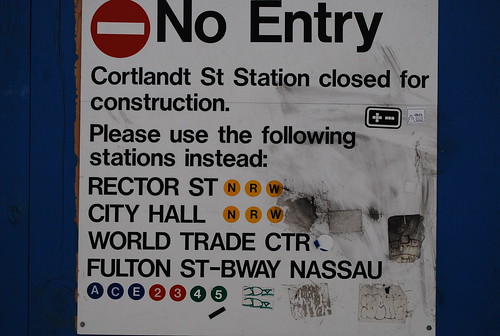This sign is more permanent than anyone would prefer. (Cortland St Station by flickr user vanillarose20)
A few weeks ago, New York City reached a milestone most politicians — and especially the Port Authority — would prefer to ignore. It’s now taken more time to figure out how long it will take to complete rebuilding Ground Zero than it did for the original construction of the Twin Towers. Just 6 years, 7 months, 30 days elapsed between the groundbreaking and the ribbon-cutting ceremonies in the late 1960s and early 1970s. Meanwhile, the Towers fell 6 years, 9 months, 21 days ago and counting.
For Lower Manhattan, the news got worse this week. On Monday, the Port Authority released a 34-page report (PDF) that explained how reconstruction at Ground Zero is well over budget and well behind schedule. And, hey, the MTA isn’t even running this show.
On Tuesday, the news took a turn toward transportation. As the Port Authority’s original report noted, Port Authority’s WTC Transportation Hub featuring Santiago Calatrava’s retractable roof/porcupine-type building was well over budget and — here’s the kicker — the final design had not yet been chosen. As The Times reports today, gone are the retractable panels, and the final design may be drastically reduced.
Now, to anyone following recent construction trends in the city, these announcements are not unexpected. In fact, the Port Authority — the only agency that has a worse time with construction timetables than the MTA — had already announced a delay in the Hub’s completion date six months ago. But this time, two key subway stations in Lower Manhattan will be impacted indefinitely by this announcement.
Both of the Cortlandt St. station stops — one on the BMT Broadway line that would service the N, R and W trains; one on the West Side IRT that would serve the 1 train — will remain closed indefinitely. According to the Port Authority, one of the many challenges they face in rebuilding at Ground Zero is doing so “while ensuring the continued uninterrupted operations of the MTA #1 and R/W subway lines.”
Worse still, though, is the indictment of the MTA in the Port Authority’s report. Difficulties with the Cortlandt St. project and the oft-delayed Fulton St. Hub are negatively impacting work at Ground Zero. Writes the PA:
The MTA is planning to rebuild the Cortlandt Street subway station, but there are design and construction issues that first need to be coordinated and agreed upon between the MTA and the Port Authority. Among the issues to be resolved include: the substantial duct work required for the MTA construction interferes with utilities on Greenwich Street; funding needs to be identified for the MTA project; the construction staging needs to be determined and an expedited schedule needs to be developed to assure that Greenwich Street can be ready in time to serve all the other projects – the Memorial, the WTC Towers, etc.
It’s so dry, yet so illuminating. The MTA isn’t sure what’s happening at Cortlandt St. while delays in the overall work at the Ground Zero make the point moot because these stations, once set to reopen in 2006 (hah!), will remain closed for indefinitely.
amNew York’s Matthew Sweeney notes that the stop on the IRT “remains as an unadorned box waiting for reconstruction.” For now, it seems, that’s the best we’ll get as that construction clock ticks ever upwards.


5 comments
It never made sense to me to build two Transit Centers, one at WTC, the other at Broadway/Fulton/Nassau, a block apart from one another — connected by an underground passageway as well. If the two agencies joined forces and finances, perhaps there would be one fully functional hub, rather than a relocated temporary PATH entrance and a vacant lot where the shops at Broadway and Fulton one stood.
I wonder what changed between the 60’s and now in terms of public construction financing and management. Are people lazier? Is less money available? Is there more corruption? Is the bureaucracy differently structured? Do people feel uninspired and depressed by what’s going on in the world?
Prices are higher. The budget for the Second System was 438 million dollars, or 5.5 billion in 2008 dollars. Nowadays the same budget suffices for SAS from 63rd to about 110th Street.
Also what is being built now is more complex because of the need to follow more stringent building codes, provide for technological amenities and every dime being spent requires a complex analysis like EIS and the like.
Worker safety is much more stringent than in the days of the original construction.